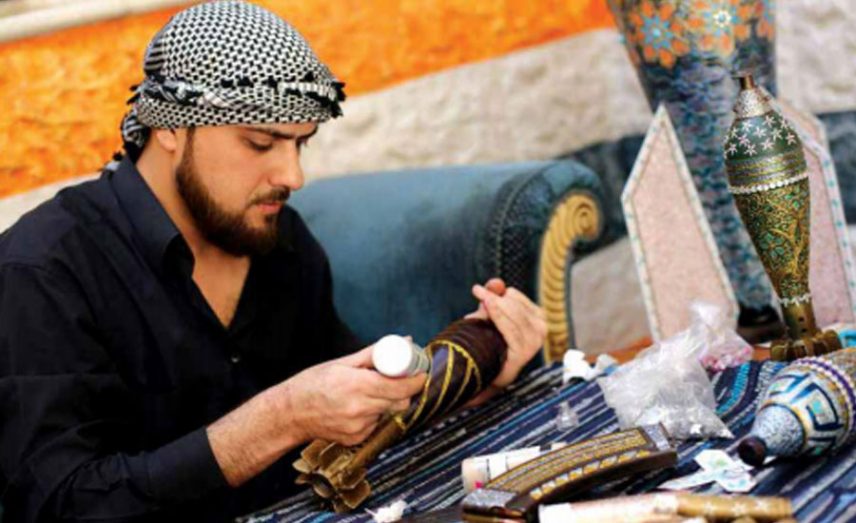“Tank shells, cluster bombs and ammunition cartridges” — they may not necessarily be tools of destruction depending on the person who uses and employs them. So what if they are turned into an artistic material?
This is what a resident of the Damascus countryside has done, calling his art “painting on death.” The impressive works made by the artist have been displayed in international exhibitions and newspapers.
“The idea of painting on death came when I came into possession of my first mortar,” Douma native, Akram Abou al-Fawz explained in an interview with Sadaa al-Sham. He continued: “The idea was to gather some of the remnants of war to make them into a pillar in a corner of my house as a testimony to what we’ve been through in the revolution. The idea of painting on them came to me to add the missing aesthetic quality and remove the tincture of death. This is how it began.”
Every artist carries in the folds of his work a message to people to deliver his ideas through a photograph or painting or sculpture. Abou al-Fawz says: “My message with this work is to every human in his environment has a different interpretation, but in general there are meanings that have consensus, and those are peace and tradition.” He adds: “With my work, I wanted to say that we are not terrorists — we have culture with deep roots, back to the beginning of creation.”
Abou al-Fawz’s journey in the world of painting was not easy, and securing the necessary materials has not been stress-free. The barriers standing in his way have sometimes forced him to stop his work. Abou al-Fawz says, “I’ve lacked materials because of rising prices and an inability to buy them, or because of the siege of the eastern Ghouta which has been going on for more than five years, and has led to a shortage of most materials. That has sometimes forced me to buy from countries around Syria, which takes a long time and higher costs.” He added: “I have a major shortage of materials, to the extent that I sometimes exchange materials and colors for others of lower quality to finish the work.”
The Damascus Ghouta native who molded death into art said: “Most paints and materials used in my work are silicon-like material, which turn into solid rubber when exposed to the air, in addition to oil and glass paints.”
“My aim was not to reach out to the world, but the situation forced it on me. My message which I’m sending through this art is the message of the Syrian revolution.”
Reaching the world with materials that we are killed with daily
The young creative has not received the necessary support to set up an exhibition of his work in his besieged city, which is undergoing bombardment. Abou al-Fawz says that, “All the work that I’ve done is with me in my house. I have not sold any works.” He said that he had a number of exhibitions outside Syria’s borders, but only through photos of his sculptures.
One of the most important exhibitions Abou al-Fawz exhibited in was on the occasion of the fourth anniversary of the Syrian revolution, held in Washington DC, and two exhibitions in Sweden, while also participating in an exhibition in Germany and others in France and Qatar.
Abou al-Fawz ended his with a message to the world, in which he said: “Everyone in my city, from institutions to individuals to military groups yearns for peace and an end to this aggression on our grieving people.”
This article was translated and edited by The Syrian Observer. Responsibility for the information and views set out in this article lies entirely with the author.


